Case Study: Wings for Life – Red Bull’s Global Success

Red Bull was founded in 1987 by Dietrich Mateschitz after he discovered energy drinks in Asia and saw an opportunity in the market. Today, the brand is sold in over 171 countries, with annual sales exceeding 6 billion cans. The drink, which contains caffeine, carbohydrates, vitamins, and taurine, is particularly popular among clubgoers who rely on its energy-boosting effects.
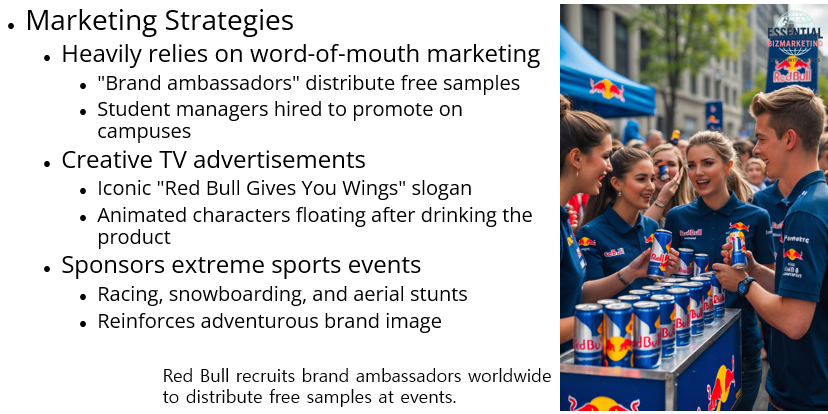
Red Bull maintains a consistent product across markets and relies heavily on word-of-mouth marketing. It recruits “brand ambassadors” to distribute free samples and hires student managers to promote the drink on campuses. Additionally, the company invests in creative TV advertisements featuring its iconic “Red Bull Gives You Wings” slogan, often portrayed through animated characters floating after drinking the product.
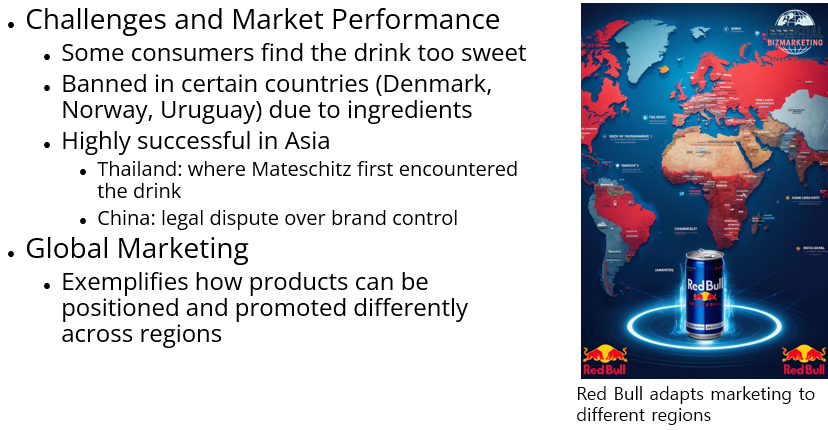
Beyond advertising, Red Bull sponsors extreme sports events, including racing, snowboarding, and aerial stunts, further reinforcing its adventurous brand image. Although some consumers find the drink too sweet and certain countries like Denmark, Norway, and Uruguay have banned it due to its ingredients, Red Bull remains highly successful, particularly in Asia. Thailand, where Mateschitz first encountered the drink, and China, where a legal dispute over brand control has emerged, are key markets for the company.
Red Bull’s global marketing strategies exemplify how products can be positioned and promoted differently in various regions.
1. Introduction to International Marketing
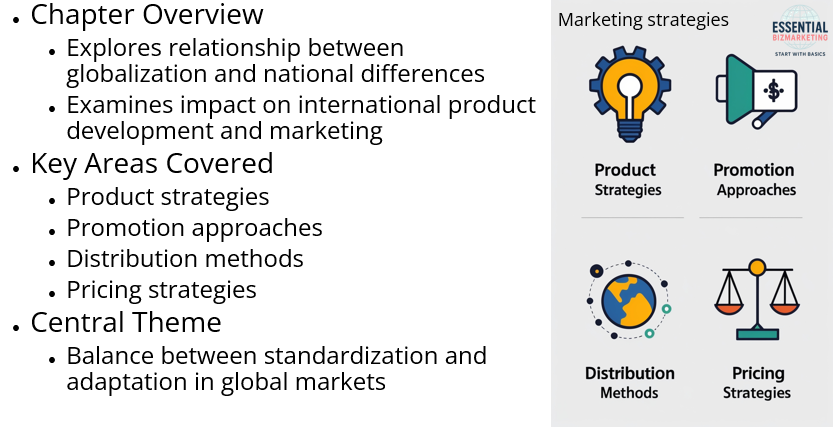
This chapter explores how globalization and national differences shape the development and marketing of products internationally. It examines key aspects such as product strategies, promotion, distribution, and pricing. The chapter also discusses the balance between standardization and adaptation in global markets.
2. Developing International Product Strategies
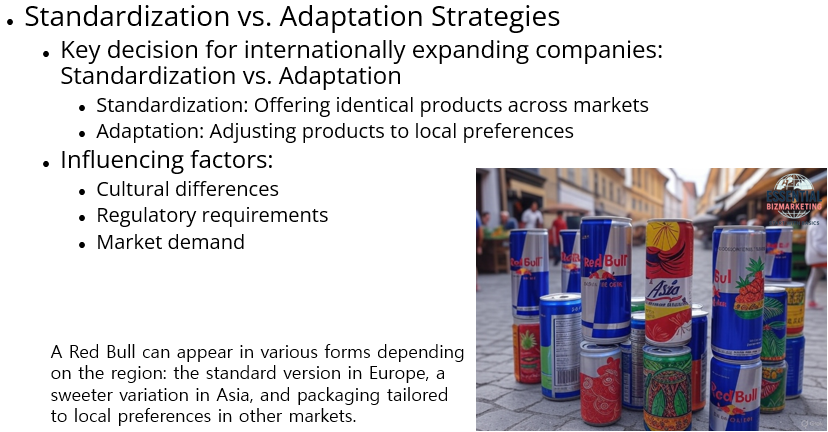
Companies expanding internationally must decide whether to standardize their products across different markets or adapt them to local preferences. The debate between standardization and adaptation is influenced by factors such as cultural differences, regulatory requirements, and market demand.
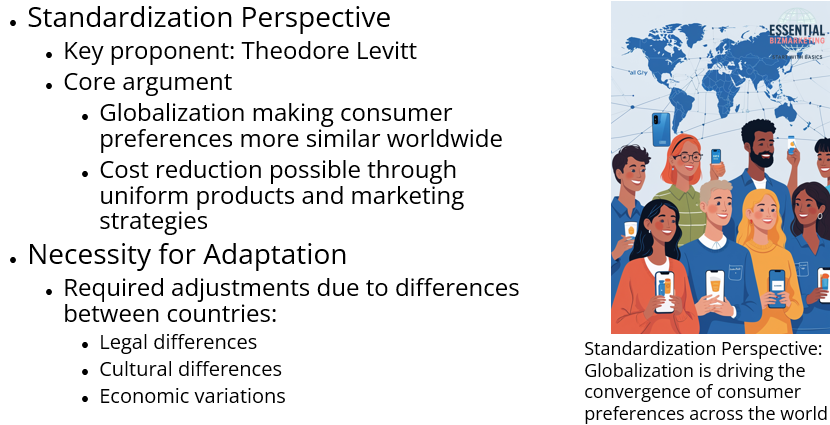
Standardization proponents, including Theodore Levitt, argue that globalization is making consumer preferences more similar worldwide, allowing companies to reduce costs by offering uniform products and marketing strategies. However, adaptation is often necessary due to legal, cultural, and economic variations among different countries.
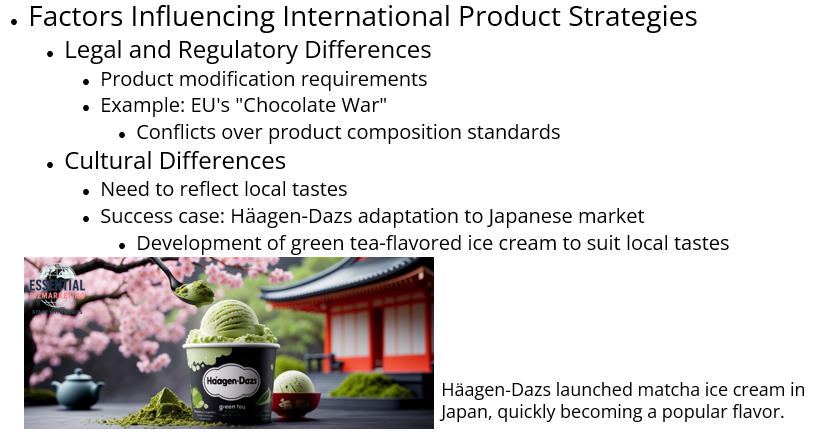
Several factors influence international product strategies. Legal and regulatory differences often require companies to modify their products. For example, the European Union’s Chocolate War highlighted conflicts over product composition standards. Cultural differences also play a crucial role. Häagen-Dazs successfully adapted to the Japanese market by developing green tea-flavored ice cream to suit local tastes.
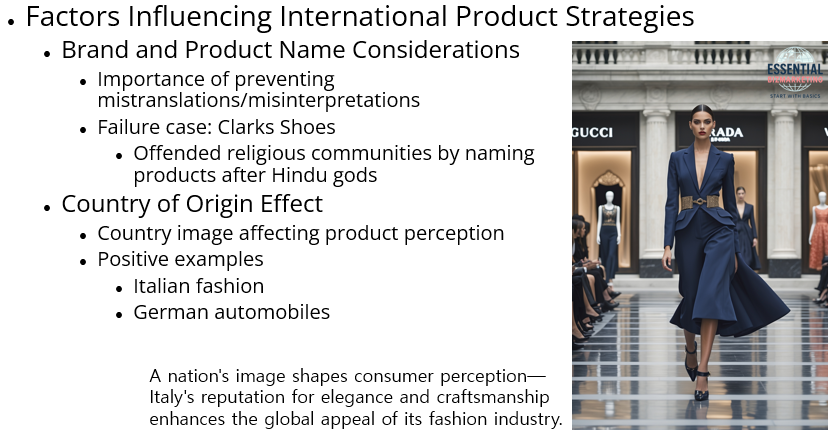
Brand and product names must also be considered carefully since misinterpretations can lead to marketing failures, such as Clarks Shoes unintentionally offending religious communities by naming products after Hindu gods.
The perception of a product is also affected by the image of the country where it is designed, manufactured, or assembled. Products associated with nations known for high-quality goods, such as Italian fashion and German automobiles, tend to be more positively received by consumers.
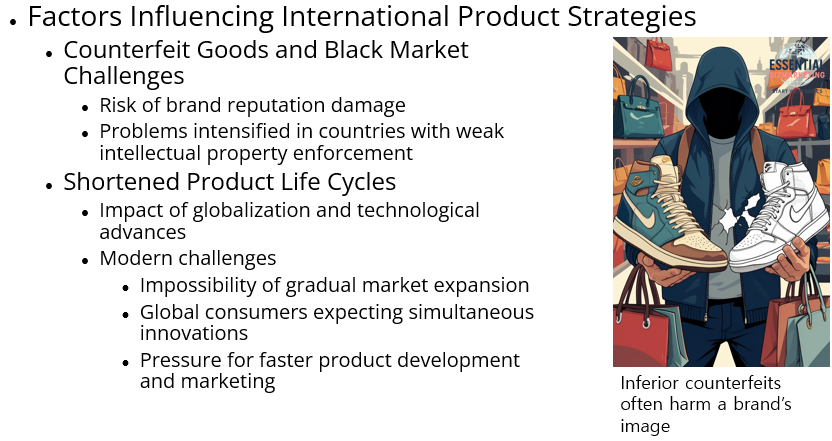
However, counterfeit goods and black markets pose significant challenges for international companies by damaging brand reputation, particularly in countries with weak intellectual property enforcement.
Globalization and technological advances have also led to shorter product life cycles. Companies can no longer introduce products in one market and gradually expand into others over time. Instead, global consumers expect to receive the latest innovations at the same time, which pressures businesses to develop and market products more rapidly.
3. International Promotional Strategies
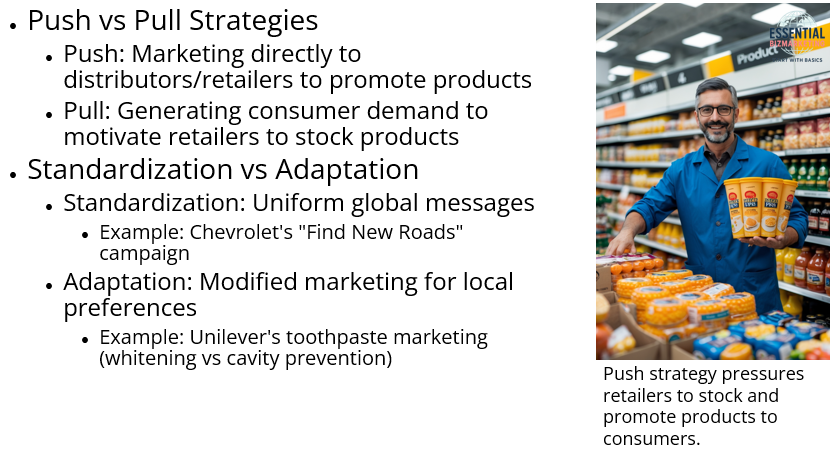
Promotional strategies help companies communicate the value of their products to consumers in different markets. Two primary approaches to international promotion include push and pull strategies. A push strategy focuses on marketing products directly to distributors, retailers, and intermediaries to encourage them to carry and promote the products. A pull strategy, on the other hand, aims to generate consumer demand, which in turn motivates retailers to stock the product.
The decision to standardize or adapt promotional strategies depends on market conditions. Some companies use a standardized approach, employing uniform global messages, as seen in Chevrolet’s “Find New Roads” campaign. Others adapt their marketing messages to cater to local consumer preferences. For example, Unilever modifies its toothpaste marketing depending on whether the target audience values whiter teeth or cavity prevention.

International advertising presents additional challenges, as cultural differences and language barriers may lead to misinterpretations. Companies must carefully localize advertisements to ensure their messages are understood correctly in different regions. Sponsoring global sporting events, such as the Olympics or the FIFA World Cup, allows companies to reach massive audiences worldwide while maintaining brand consistency.
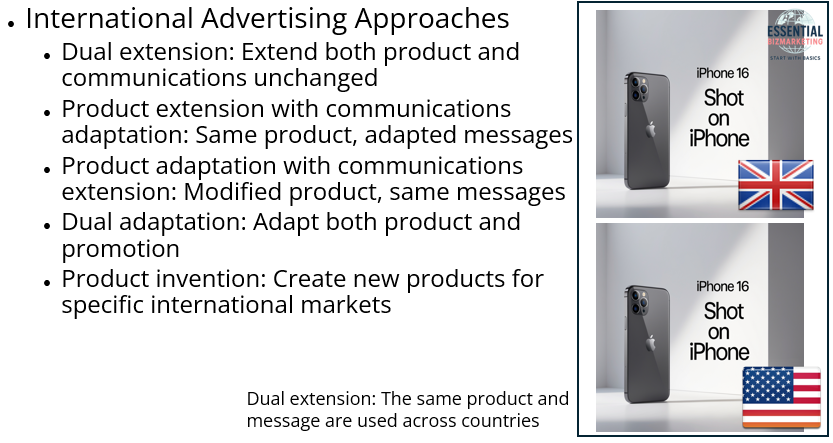
When developing international advertising strategies, businesses can choose from several approaches. Some companies extend both their product and communication strategies without modification, a practice known as dual extension. Others retain the same product but adapt promotional messages to suit cultural differences, which is called product extension with communications adaptation. In some cases, companies modify their products but keep the same promotional messages, known as product adaptation with communications extension. A more complex strategy involves adapting both the product and the promotion, referred to as dual adaptation. In situations where neither standardization nor adaptation is viable, companies may engage in product invention by creating entirely new products tailored to specific international markets.
4. International Distribution Strategies
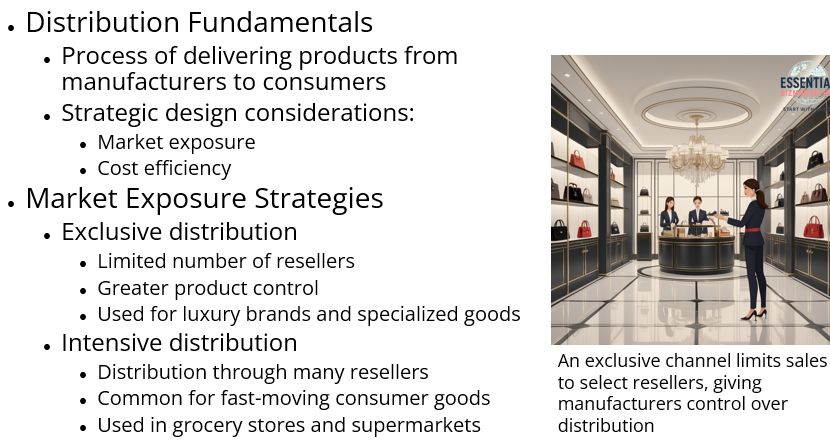
Distribution involves the process of delivering products from manufacturers to consumers. Companies must carefully design their distribution strategies by considering factors such as market exposure and cost efficiency.
Market exposure decisions determine whether a company should pursue an exclusive or intensive distribution strategy. An exclusive channel limits the number of resellers, providing companies with greater control over their products. This approach is often used for luxury brands or specialized goods. In contrast, an intensive channel seeks to distribute products through as many resellers as possible, which is common for fast-moving consumer goods sold in grocery stores and supermarkets.

Channel length also influences distribution costs. A direct marketing approach involves selling products directly to consumers, eliminating intermediaries. A longer distribution channel, with multiple intermediaries, increases costs but expands product reach. Companies with price-sensitive products must consider these cost implications when selecting distribution methods.
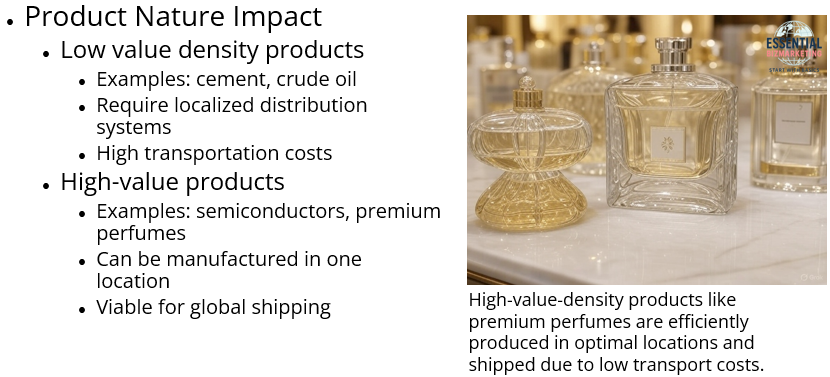
The nature of a product affects distribution strategies. Products with low value density, such as cement or crude oil, require localized distribution systems due to high transportation costs. In contrast, high-value products like semiconductors and premium perfumes can be manufactured in one location and shipped globally.

International distribution can be challenging due to factors such as market unfamiliarity and security risks. Companies that fail to understand local distribution systems may suffer financial losses, as seen when Amway encountered fraudulent product returns in China due to a misjudged refund policy. In countries with high crime rates and corruption, transporting goods can be risky. Acer, for example, faced major distribution challenges in Russia, where truck hijackings were common, and eventually relied on Russian distributors who were better equipped to navigate the local system.
5. International Pricing Strategies
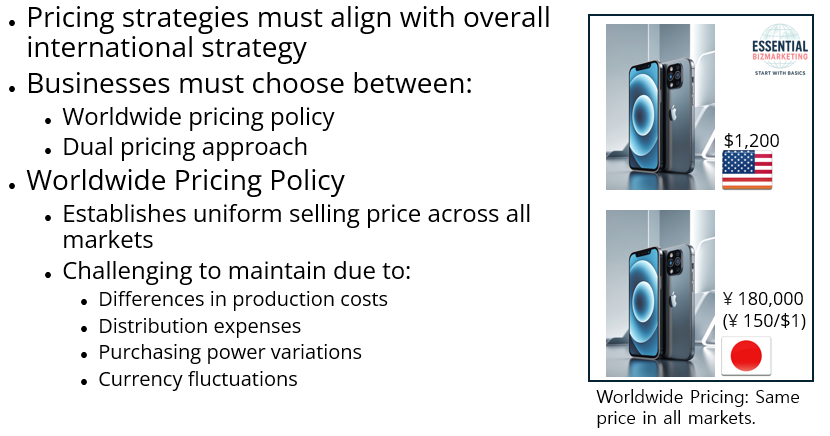
Pricing strategies must align with a company’s overall international strategy. Businesses must decide between adopting a worldwide pricing policy or a dual pricing approach.
A worldwide pricing policy establishes a uniform selling price across all markets. However, maintaining the same price globally is difficult due to differences in production costs, distribution expenses, purchasing power, and currency fluctuations.
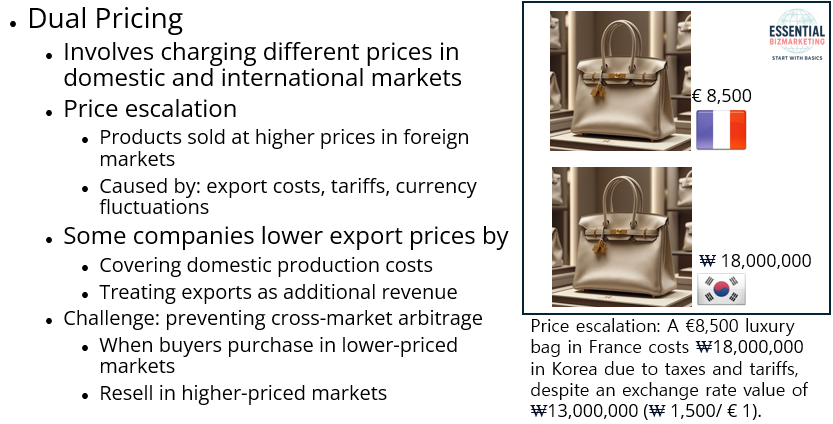
Dual pricing involves charging different prices in domestic and international markets. Price escalation occurs when a product is sold at a higher price in foreign markets due to additional export costs, tariffs, and currency fluctuations. Some companies lower their export prices by covering domestic production costs while treating exports as additional revenue. However, businesses must prevent cross-market arbitrage, where buyers purchase products in lower-priced markets and resell them in higher-priced ones.
Several additional factors influence international pricing decisions. Transfer pricing refers to the prices charged for goods exchanged between a parent company and its subsidiaries. Some firms have historically manipulated transfer pricing to reduce tax burdens, but stricter regulations now require companies to follow arm’s length pricing, which means setting prices at fair market value.
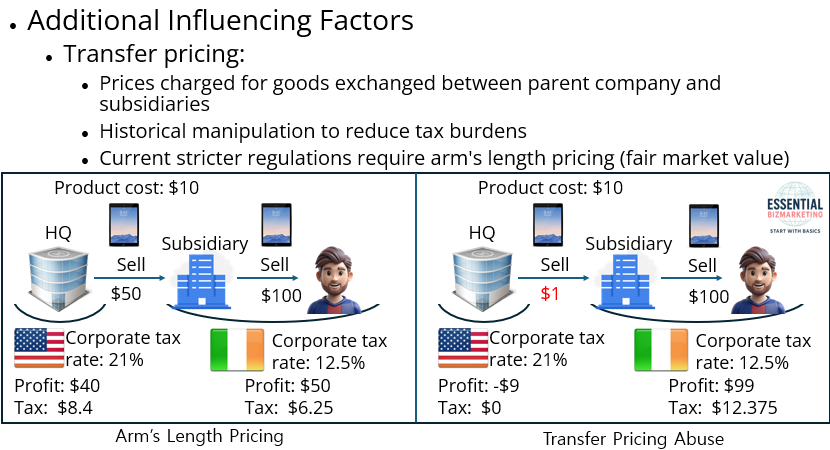
The image compares Arm’s Length Pricing and Transfer Pricing Abuse in international transactions between a parent company and its subsidiary. On the left side, under Arm’s Length Pricing, the HQ in the U.S. sells a product to its subsidiary in Ireland for $50, which is a fair market price considering the product cost of $10. The subsidiary then sells the product to a customer for $100. As a result, the HQ earns a profit of $40 and pays $8.4 in taxes at a corporate tax rate of 21%, while the subsidiary earns a profit of $50 and pays $6.25 in taxes at a corporate tax rate of 12.5%. The total tax paid under this method amounts to $14.65, ensuring that both entities contribute fairly to their respective tax jurisdictions.
On the right side, under Transfer Pricing Abuse, the HQ sells the same product to its subsidiary for just $1, an artificially low price that shifts most of the profit to the subsidiary. The subsidiary then sells the product to the customer for $100, just as in the previous scenario. However, this time, the HQ reports a loss of $9 and pays no taxes, while the subsidiary records a profit of $99 and pays $12.375 in taxes at a lower corporate tax rate of 12.5%. By using this strategy, the company reduces its total tax liability compared to the Arm’s Length Pricing method.
This practice allows companies to shift profits to subsidiaries in low-tax jurisdictions, ultimately minimizing their overall tax burden. However, such tax avoidance strategies are subject to scrutiny and regulation by tax authorities to prevent unfair advantages and ensure compliance with Arm’s Length Principle, which requires transactions between related entities to be conducted at fair market value.
Governments also impose price controls to regulate pricing. Some nations implement upper-limit price controls to prevent inflation, while others enforce lower-limit controls to protect local industries from cheap imports. Another pricing challenge is dumping, which occurs when companies sell products at lower prices in foreign markets than in their home country. Accusations of dumping often lead to anti-dumping tariffs aimed at preventing unfair competition.

The image illustrates the concept of dumping and the application of anti-dumping tariffs in international trade. In the first scenario on the left, a Chinese company sells steel in its domestic market at $700 per ton but exports the same product to the U.S. at a significantly lower price of $500 per ton. This price difference gives the Chinese company a competitive advantage over U.S. steel producers, who struggle to compete with the artificially low prices. This practice is an example of dumping, where a company sells products at lower prices in foreign markets than in its home country to gain market share.
In the second scenario on the right, the U.S. government responds by imposing an anti-dumping duty of 40% on the imported steel. This additional tariff increases the final price of the Chinese steel in the U.S. market to $700 per ton, aligning it with the domestic price in China. By implementing the tariff, the U.S. government aims to prevent unfair competition and protect local industries from price manipulation by foreign exporters. This regulatory measure ensures that imported goods do not undermine domestic producers by being sold at below-market prices.
6. Conclusion
This chapter highlights the complexities of international marketing strategies. Companies must carefully assess whether to standardize or adapt their products and promotional messages, taking cultural and legal factors into account. They must also navigate distribution challenges and determine appropriate pricing strategies while considering economic conditions and government regulations. A successful international marketing strategy requires balancing global efficiency with local responsiveness to meet consumer needs across different markets.
Related videos
- How Global Brands Adapt to Local Tastes.
- The Business of World Cup Sponsorships
- Supply Chain Challenges in Global Distribution
- How Amazon Revolutionized Global Distribution
- Understanding Transfer Pricing
- Country of origin
📚 References
Wild, J. J., & Wild, K. L. (2019). International business: The challenges of globalization (9th ed.). Pearson.
📁 Start exploring the Blog
📘 Or learn more About this site
🧵 Or follow along on X (Twitter)
🔎 Looking for sharp perspectives on global trade and markets?
I recommend @GONOGO_Korea as a resource I trust and regularly learn from.
